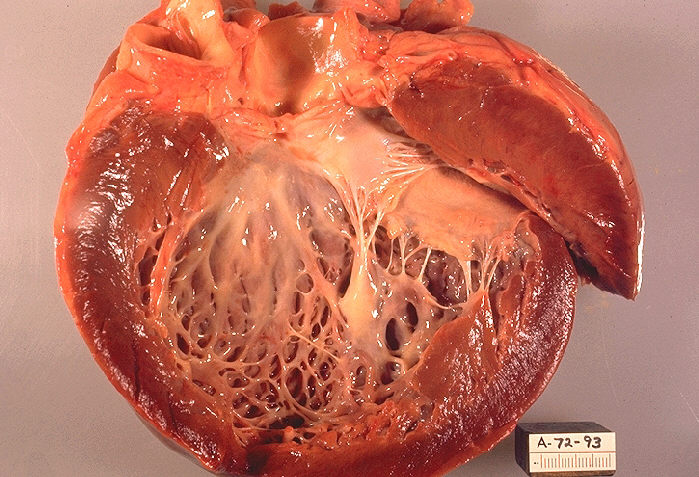
Above: Gross pathology of the heart showing idiopathic cardiomyopathy, which is similar to dilated cardiomyopathy. The opened left ventricle of heart shows a thickened, dilated left ventricle with subendocardial fibrosis manifested as increased whiteness of endocardium.
Sixteen-year-old basketball player Wes Leonard died of cardiac arrest caused by dilated cardiomyopathy (an enlarged heart), according to a Michigan medical examiner. Leonard collapsed during the post-game celebration for his Fennville High School team the other after scoring the winning basket near the end of the overtime game.
Cardiomyopathy is a condition in which the heart muscle becomes enlarged or thickened and weakened, making it unable to pump blood effectively. The heart, like any other muscle, increases in mass when it is exercised, and it is not unusual for athletes such as basketball players and distance runners to have enlarged hearts, or even cardiomyopathy. But to some people, cardiomyopathy can be harmful or even deadly.
Dilated cardiomyopathy is the most common form of cardiomyopathy according to the U.S. National Institutes of Health. It can be caused by a genetic disorder or by a variety of other problems including heart rhythm disturbances, infection, drug or alcohol abuse, medications, or even high blood pressure.
Unfortunately, Wes Leonard is only the latest high-profile athlete to die because of cardiomyopathy, which often causes no symptoms. In many cases, the person doesn't know anything is wrong until he or she collapses during or after a practice or game. The lucky ones survive the first incident and get treatment to prevent reoccurrence.
American distance runner Ryan Shay died suddenly in 2007 while running the U.S. Olympic half marathon trials in New York City. His father said that Shay had an enlarged heart that was first diagnosed when the runner was 14. Shay's death was attributed to "cardiac arrhythmia due to cardiac hypertrophy with patchy fibrosis." Hypertrophy is a thickening of the heart muscle.
After Shay's death, a number of medical experts said that an enlarged heart was "the biggest cause of sudden death among young athletes."
Athletes and former athletes who have died of hypertrophic cardiomyopathy include Reggie Lewis of the Boston Celtics, Loyola Marymount University basketball player Hank Gathers, and Maggie Dixon, coach of the Army women's basketball team, who was a former college player. All were under the age of 30 when they died.
After Dixon's death, the Maggie Dixon Foundation was set up to raise awareness of and screening for heart arrhythmia and sudden cardiac death in young people. Each December the Maggie Dixon Classic features four of the nation's top women's college basketball team playing a doubleheader in New York's Madison Square Garden to promote the cause and screen attendees for heart problems.
It's hoped that the death of Wes Leonard will bring more attention to cardiomyopathy and other heart conditions in young people, and make athletes, coaches, and parents more aware of the problem.
No comments:
Post a Comment